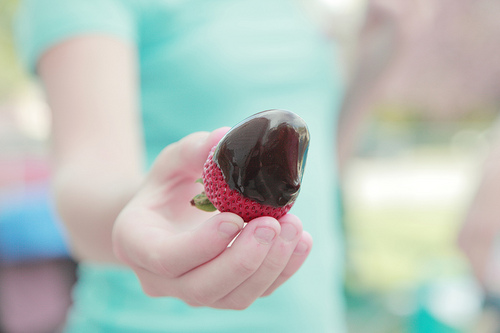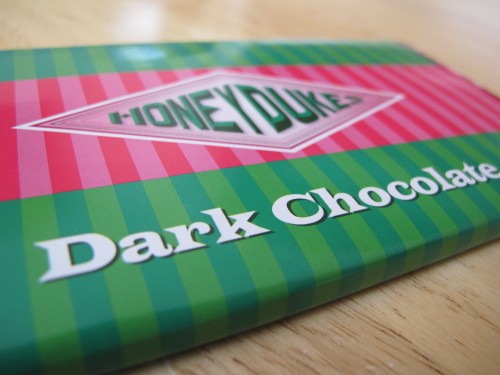Chocolate in Pictures

Chocolate Dipped Strawberry by Poppy Thomas-Hill

Liquid Truffle at French Broad Chocolate Lounge by David Berkowitz

Chocolate Cake by Ralph Daily

Pure Chocolate by Dakotilla

Chocolate in the Grass by Jens Schott Knudsen

Chocolate Brownies by Waleed Alzuhair

Chocolate Camera by Mitchell Joyce
Wacky World of Choc Wednesdays: Chocolate Scent Marketing
Over the past couple of weeks, I’ve struggled to ward off the last of a dreaded summer cold. Fighting a fever while Boston matched its highest temperature ever (!) wasn’t exactly fun, but my main complaint stems from the cold’s interference with my sense of smell. For several days, food lost all its appeal and the thought of eating normally beloved chocolate actually made me cringe. It’s only temporary, I told myself over and over, hopeless with despair. As is so often the case when I face times of strife, I begged the internet for distraction.
Turns out, marketers have long understood the importance of scent to triggering the desires of smellers. That’s why, when I read this article in my sinus pressure induced haze, all I could think was “I wish I could go smell that right now!”
From the article:
A supermarket chain thinks the fastest way to its customers’ pockets is through their noses, so it’s filling up the aisles with intoxicating, artificial food aromas to entice customers to buy.
A Net Cost supermarket in Brooklyn, N.Y., has specialized scent machines mounted on its walls that fill the air with a never-ending scent of decadent milk chocolate or fresh-baked bread, among other scents.
The Brooklyn supermarket has five of the machines, including a grapefruit smell in the produce section, chocolate in the candy aisle and rosemary focaccia by the bakery.
These scent machines are pricey, costing the supermarket $99/month. The store’s merchandise coordinator, however, states that she has already seen a 7% rise in produce sales, which she attributes to use of the machines. Not too shabby!
Learn more in this video from CBS News:
There are a number of other notable chocolate scent marketing cases. For example, when Verizon launched its LG Chocolate phone back in 2006, it used small plastic strips that emitted chocolate scent in its stores to lure customers in and excite their interest. And, according to an in-depth article from the Los Angeles Times, chocolate scent marketing has proven efficacy: “In 2006, when ScentAndrea, a scent marketing company in Santa Barbara, put chocolate scent strips on 33 vending machines in factory break rooms in Ventura (plus a sign that said it was Hershey’s candy people were smelling) the brand’s sales tripled.”
The product lines for scent marketing are really fun to learn about – there are scent cannons to remove odors, scent lights to project images and release scents, scented digital signage for use in store displays… There’s even a whole bunch of so called scent science in process. And just when I was thinking it’s too bad we can’t yet smell scents through our web browsers, I ran across this Scent Mouse, which can be customized to release up to four scents during the exploration of a website, and the ScentScape which claims to deliver “the NEXT Dimension of Digital Media” by releasing scents during gaming.
The scent marketing industry brings in hundreds of millions of dollars a year and is still expanding. Get a whiff of that chocolate.
For a basic intro to the field, check out this video, “What is Scent Marketing”:
Also check out the following companies and institutions to get a better sense for the industry:
ScentAir
ScentAndrea
Scent Marketing Institute
Sniff, sniff!
How to save money at Whole Foods
If you’re like me and you’ve got a cabinet full of chocolate and all you can think of is how much more you need to buy and try, and you dream that all your out of town trips could center around visiting chocolatiers, and when you bake anything for a loved one you can’t live with yourself unless you dump at least a pound of high quality chocolate into the batter, then you’re probably spending a good chunk of change on the bittersweet stuff.
I have strong opinions regarding the cost of chocolate (and other foods) and on what I believe to be unrealistic expectations for cheapness perpetuated by a broken food system and bizarre prices that are only possible due to poorly directed and heavily lobbied for farm and industry subsidies, multinational corporations run amok, and the exploitation of laborers at many stages of production… PHEW!
On the other hand, food insecurity is a major problem in the US, with about 1 in 7 Americans currently on food stamps. This grave issue goes beyond just cost to availability. Check out the USDA Food Desert Locator, which provides a “spatial overview of low-income neighborhoods with high concentrations of people who are far from a grocery store.” On this map, huge swaths of our country, home to millions of people, are highlighted in pink, meaning food access is extremely limited in those areas.
News on food insecurity is everywhere these days, as farmers struggle to grow their own food while producing large quantities of commodity crops and urban-suburban families suffer from limited access to fresh food options. First Lady Michelle Obama, who has valiantly intervened in numerous food and health related problems in our country, is now directly involved in working to eliminate food insecurity.
Here in Massachusetts, where, on the whole, we are fortunate to have readily available food, I have nonetheless observed the struggles of friends and acquaintances for appropriate food access. A recent Boston Globe article detailed one type of grueling local food scarcity amongst visitors to food pantries. There is a lot more to say on all of this in subsequent posts. The messy interconnectedness of our global food system sometimes seems enough to drive us all batty. Let it stand for now that the development of solutions to food insecurity problems greatly preoccupies me.
That’s why last weekend, while my Twitter and Facebook feeds erupted with Women’s World Cup excitement, I was equally engrossed in a sporting event of sorts — the Extreme Couponing marathon on TLC. Watching this show positively titillates. It’s like riding a roller coaster or bungee jumping… or legally robbing a supermarket. The short of it: intensely organized people spend dozens of hours finding, cataloging, and calculating coupons, then go to the grocery store where they acquire hundreds of dollars worth of products for nearly free. Watch the show. The extreme couponers are compulsive pennypinching heroes, true pros at gaming food costs! And most of them, as it turns out, were inspired to coupon in the extreme when their own families faced food insecurity.
There are countless blogs and guides online with tips for saving money at supermarkets, drug stores, and big-box stores. Given my own food politics inclinations and my geographic location, I tend to do most of my food shopping at Whole Foods, local family-owned shops, and seasonal farmers markets. I take money saving and frugality seriously, and I love a good bargain as much as the next person.
Whole Foods is still subject to the well known but somewhat unfair and outdated epithet, Whole Paycheck. Its brand is associated with privileged yuppies and gentrification as much as it is with healthy, ethical food. Boston became a part of the debate over these associations and the store’s pricing this year when citizens of the neighborhood of Jamaica Plain spoke out for and against the planned opening of a Whole Foods store there. In response to concerns over pricing, it was found that, in fact, Whole Foods Isn’t That Expensive. And the truth of the matter is, here in Cambridge, Whole Foods is an excellent shopping option, and often, because we are lucky to have three locations within the city’s borders, it is the most convenient one for people of diverse income levels.
Extreme couponing is not a realistic goal for most people, nor will it ever be THE solution to food insecurity problems. Yet the skills that extreme couponers have and their heightened awareness surrounding shopping and budgeting is something that we can all benefit from. Recently, in the interest of improving my own food shopping skills, I challenged myself to learn how to save serious cash when shopping at Whole Foods. So, no matter what drives you to coupon, whether its to deal with the very real problem of food insecurity, because you want to save or donate money, or because you’ve got a tongue-in-cheek desire to accommodate a chocolate buying habit, I hope that the information below will prove useful.
According to my preliminary calculations, I should be able to save anywhere from $25 or more on my Whole Foods grocery bill next week.
Here’s what I’ve learned:
Tips for saving money at Whole Foods
- Buy local, seasonal produce and save. While this isn’t a hard and fast rule, I often find that local, seasonal fruits and vegetables are less costly than imported, out of season ones. I buy organic produce almost exclusively now, for the simple reason that pesticides are harmful for farm workers, the environment, and me. Plus, my experience has been that organic produce most often tastes much better. Admittedly, organic produce is sometimes more expensive than non-organic, but well, healing people and the environment is very expensive, and this is a cost-benefit choice that I am fortunate enough to make.
- Consult The Whole Deal Value Guide, which is available by email, online, or in stores. The Whole Deal is published throughout the year. It includes the following money saving options: dozens of printable coupons, a list of Sure Deals (seasonal sale items), Three Under $3 (three kitchen staples for under $3 each), Budget Meal suggestions, and Budget Friendly Recipes. Numerous blogs also take on the challenge of budget friendly meal planning.
- Download the PDF file of Weekly Buys for your local store. Do this by going to the Whole Foods main website. On the home page, you will see a highlighted box with the text “What’s On Sale?” Input your state and choose your local store, then click download. Note: In addition to the Weekly Buys, there is an in store publication called “Weekender” with last-minute specials for Friday, Saturday, and Sunday. My local Whole Foods offers significant discounts on *at least* 50 items each week.
- When you’re in the store, look around and ask. Sometimes there are in store specials like Madness Sales or One Day Sales that you won’t necessarily know about unless you run across them at the store. You can also stop by the Customer Service Desk and ask questions about deals. The staff at my local store are wonderful and very helpful; it is always a pleasure to speak with them.
- Volume discounts. If you buy a full case or a large amount of one of your much used items, you might be eligible for a volume discount from the store (sometimes as much as 10 or 20% off). Ask at the Customer Service Desk for more information.
- Bulk bins. The bulk section of any Whole Foods store is easily distinguishable by its large clear bins filled with grains, dried beans, dried fruits, nuts, candies, and more. You self select your quantity, use minimal packaging, and store things without refrigeration, making this an ecofriendly and economical choice.
- Buy “generic” from the wide range of Whole Foods’ own 365 Everyday Value brand. This post from Apartment Therapy discusses the cost saving possibility of many of the high quality 365 products.
- Sign up for all the Whole Foods email newsletters, which contain information about coupons, sales, and more. (Bonus: If you sign up right now, you can enter to win a $50 Gift Card.)
- Find manufacturer’s coupons for your favorite brands and use them at Whole Foods. There are many ways to find these coupons and they are elaborated in wonderful detail on many couponing blogs. A few of my favorite spots are: 1) You can check the websites and sign up for newsletters individually for your favorite products. Here are a couple of starter lists with links to common brands: Best Organic Food Coupons, Frugal Living. I also recommend following your favorite brands on Twitter and “Like”-ing them on Facebook for real time updates on deals. 2) There are many excellent blogs devoted to couponing that link to coupons for organic and natural products. Check out Mambo Sprouts and Thrifty Mama to start. Also be sure to follow them on Twitter and Facebook, sign up for their newsletters, etc. 3) Check out your local newspaper coupon circulars, which are typically published once or twice a week.
- Follow Whole Foods on Twitter and Facebook. Also follow your local Whole Foods (as well as your favorite family-owned shops and farmers markets).
- Many of the publications, both digital and otherwise (e.g. Delicious Living magazine), from newhope360 offer coupons.
Tips on organizing all of these deal types
- Print out coupons that require printing when you find them. File them into a binder or plastic box. Consider organizing them by expiration date or by product name/type, whatever makes more sense for you. Don’t be embarrassed about bringing the whole thing with you to the store. Just tell yourself: it’s more embarrassing to miss good deals!
- Use your RSS feed, Google Reader, or another tool to read and organize coupon blog posts all in one spot.
- Set up categories in your email to make coupon related emails quick and easy to sort. I use Gmail Labels.
- Set up organizational lists on Twitter, groups on Facebook, or eventually circles on Google+ with your favorite feeds.
- I use the excellent tool Evernote for taking notes and archiving all of my couponing lists and links — it works online and syncs directly to my Android phone. Very handy for organizing shopping expeditions!
- Explore apps for your smartphone. There are a number of grocery, shopping, listmaking, and coupon apps out there. I have had good luck so far with the Android apps The Coupons App and GeoQpons. I use them mostly for retail shopping like clothing and home decor.
- Couple all of the above with a good calendar app that syncs with your smartphone and you can keep track of those tricky sales timelines and expiration dates!
Happy saving, chocoholics!
Wacky World of Choc Wednesdays: Harry Potter’s chocolate habit
“Chocolate. Eat. It’ll help.”
~Remus Lupin to Harry Potter, Harry Potter and the Prisoner of Azkaban
The interwebs are all abuzz for Harry Potter, and rightly so, in celebration of the release of the last film installment. For lovers of the books and films alike, this is a very exciting, although bittersweet time.
All the more appropriate, then, to consider the importance of chocolate in the wizarding world. Its comforting properties for emotional fans are most welcome now.
Not long ago, a delightful friend visited the Wizarding World of Harry Potter, a new theme park at Universal Orlando. When I saw her soon after, she generously presented me with this special token – the Honeydukes Dark Chocolate bar.
Of course I can’t eat it yet. It’s too special. I need to stare at it and desire it for a long time first. Or save it for use in the event of a Dementor attack.
The gift of this bar and my friend’s contagious enthusiasm for Harry Potter rekindled my curiosity and got me sniffing around for chocolate’s place in the Harry Potter stories. As it turns out, those wonderful wizards just might be a bunch of chocoholics like us Muggles (or Muggle-born, as the case might be).
According to the Harry Potter Wiki:
Chocolate has special properties in the wizarding world.
Not only does it make a wonderful treat for the consumer, but it serves as a powerful and excellent antidote for the chilling, cold effect produced by contact with Dementors, and other particularly nasty forms of dark magic. Remus Lupin carried chocolate with him on the Hogwarts Express and gave Harry Potter some after the latter was attacked by a Dementor. When Madam Pomfrey heard that Remus Lupin had given Harry chocolate after his encounter with the Dementor, she nodded approvingly and stated that “at last, we have a Defence Against the Dark Arts teacher who knows his remedies.” She herself used a large chunk of Honeydukes chocolate in the hospital wing to treat Harry Potter and Hermione Granger after they and Sirius Black were attacked by several Dementors in 1994.
Throughout the books, Harry and his fellow wizards stock up on treats at the beloved Honeydukes, a sweet shop in picturesque, magical Hogsmeade Village. (Like all excellent candy shops, its basement hides a secrete passageway to Hogwarts.) References to all manner of candy, much of it chocolatey, abound. There’s Charm Choc, Chocoballs, Chocolate Cauldrons, Chocolate Frogs, Chocolate Skeletons, Chocolate Wands, Choco-Loco, exploding bonbons (which contain pure cocoa and coconut dynamite!), Fudge Flies, Shock-o-Choc, and Wizochoc, just to name a few. The Harry Potter Wiki provides a comprehensive list.
But where do we, the humble, hungry fans, find chocolate suitable for a wizard’s cravings and/or antidotal needs?
We’re in luck, thanks to the Wizarding World’s Honeydukes Homemade Sweets shop, which now has a US location and countrywide distribution of a line of Harry Potter tie-in candies that are actually available in real life.
Universal describes Honeydukes as:
A must-stop for visitors to Hogsmeade, at Honeydukes the shelves are lined with all manner of colorful sweets, including Acid Pops, exploding bonbons, Cauldron Cakes, treacle fudge, Fizzing Whizzbees, and Chocolate Frogs, which contain a wizard training card in each box. Inside the shop you can fill up a bag of Bertie Bott’s Every-Flavour Beans… who knows what tasty (or not so tasty) flavors you’ll discover! The shop also offers other classic favorites such as chocolates and fudge.
Here’s a video showing the theme park location of the sweets shop:
I find myself happily caught up in the Harry Potter frenzy. I even watched the sappy J.K. Rowling docudrama (Magic Beyond Words: The J.K. Rowling Story, starring Poppy Montgomery) on Lifetime — it was cloyingly adorable. In doing this research on chocolate, I’ve decided that there are several wizard candies that I’d like to try. They are: the Honeydukes milk chocolate bar, Chocolate Frogs, Bertie Bott’s Jelly Beans (so eww but so cool!), Fudge Flies, Droobles Best Blowing Gum, Jelly Slugs, Acid Pops, and Fizzing Whizbees.
Oh, who am I kidding, I’d like to try them all. And I plan to.
“After all, it does not do to dwell on dreams and forget to live, remember that.” (wisdom from Albus Dumbledore, quoted in Harry Potter and the Sorcerer’s Stone)
A note on the ethics behind this line of candy: The company that produces Harry Potter chocolate received a failing grade from the International Labor Rights Forum. Members of The Harry Potter Alliance, a non-profit organization devoted to civic engagement using parallels from the Harry Potter books, have recently made great strides in asking Warner Bros. to choose fair trade chocolate for its candy products. Actors from the film series have also joined in this active campaign. See this Child Slavery Horcrux Update for more information. I plan to get involved immediately and I am hopeful that this continued advocacy and intervention will make a difference.
Wacky World of Choc Wednesdays: Chocolate Stop Motion Videos
This week’s focus is on chocolate, artistry, and technology once again, this time in the form of videos that apply stop motion animation techniques to chocolate. Chocolate lends itself well to stop motion and recent use of the technique ranges from slick pro jobs with fancy props, lighting, and the use of sophisticated software to DIY digital camera+candy+home computer work done on the cheap.
A friend of a friend passed on this whimsical video for Jesse & Joy’s “Chocolate,” directed by Carlos Lopez Estrada:
The stop motion video uses dozens of different foods, chocolate and cookies principal among them, and was put together by an incredibly artistic (and organized!) crew. It’s result is a gorgeous mix of organic materials and technological possibility. I especially love the elephant drummer and the cheery singing dairy cows. Watch the behind the scenes video for a look at how they used a torch to melt chocolate through a metal table. Don’t try this at home, kids.
The chorus of the song, first in the original Spanish, then roughly translated into English:
Nuestro amor sabe a chocolate
Un corazón de bombón que late
Nuestro amor sabe a chocolate
Oh oh oh oh ohOur love knows chocolate
A chocolate heart that beats
Our love knows chocolate
Oh oh oh oh oh
Cadbury Creme Egg launched an ad campaign in 2008 with the absurd slogan “Release the Goo.” The campaign has a website linking to games, apps, and consumer generated content, all centered around dares. It also includes a number of short stop motion videos ending with dramatic explosions of Cadbury Creme Egg gooeyness. A particularly heartwrenching example, Mousetrap:
A YouTube search reveals a host of DIY stop motion videos that involve chocolate. While these videos are not as elaborate as those of Jesse & Joy or Cadbury Creme Eggs, they are nevertheless entertaining examples of chocolate stop motion fun.
For example, there is the touching Milk Chocolate: A Love Story starring interracial chocolate bunnies:
And the riveting Chocolate Tetris played with Ritter Sport squares:
Finally, the team behind the new Sagres Preta Chocolate Beer from Portugal adapted the stop motion technique to create “the world’s first website entirely made of chocolate”, an interactive site that’s worth a look to admire its artistry. The launch of the beer in conjunction with the site has generated viral publicity on the web; blogs and feeds have discussed the site extensively over the past two months (e.g. posts from Foodista, Oddity Central, and so good magazine. Here’s a behind the scenes look at the making of the site:
So cool.






